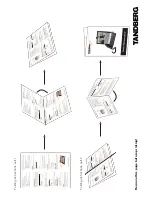
- 14 -
Maintenance
Sleeve Bearing – 500, 580, 680, 800 Frames
Access to the motor interior can be gained by
removal of the upper half of the horizontally split
bearing bracket.
1. Remove the parting bolts at the horizontal split.
2. Remove the bolts at the outer circumference of
the upper half of the split-bearing bracket.
3. Pull the upper bracket away from the face of the
frame and remove bracket.
The entire procedure can be done without disturbing
the bearing enclosure or coupling alignment of the
motor to the load. The split-bearing capsule is held
together by bolts.
Sleeve Bearing - 1120 Frames
Access to the motor interior can be gained by
removal of the bearing bracket as follows:
1. Remove the parting bolts at the horizontal split.
2. Carefully remove the top half of the bearing
housing by lifting it straight up and then pull it
away from the lower half.
Air Deflector
Air deflector construction depends on the type and
size of motor. The following conditions will be found
when accessing the motor interior;
1. 500 frame motors have air deflectors that are
retained in the fit between the bearing housing
and the stator yoke. Such air deflectors will be
removed with the bearing housing or can be
easily removed from the stator yoke after
bearing housing removal.
2. 580, 680, 800, or 1120 frame motors have air
deflectors which are mounted with bolts to the
stator yoke.
3. Air deflectors on sleeve bearing motors are
horizontally split.
Cleanliness
The exterior should be kept free of oil, dust, dirt,
water, and chemical. It is particularly important to
keep the air intake and exhaust openings free of
obstructions.
NOTE
If equipment is operated intermittently in very damp
locations, it should be protected by space heaters. To
retard corrosion, grease all machined fits when the
unit is reassembled after a maintenance check.
Loading
Overloading causes overheating and reduces
insulation life. A winding subjected to a 10°C
temperature rise above the maximum limit for its
class may have its insulation life halved.
Underloading a motor is improper as it lowers the
motor power factor and efficiency which results in
higher power cost.
Temperature
Electrical apparatus operating under normal
conditions becomes quite warm. Although some
places may feel hot to the touch, the unit may be
within limits. If checking total temperature by
winding resistance or imbedded detector (RTD), the
total temperature should not exceed the following:
When operating at full load:
Class of Insulation System
B F H
Temp. by
Resistance
All HP
120°C
(248°F)
145°C
(293°F)
165°C
(329°F)
1500HP
or less
130°C
(266°F)
155°C
(311°F)
180°C
(356°F)
Over
1500HP
-Under
7000V
125°C
(257°F)
150°C
(302°F)
175°C
(347°F)
Temp. by
Embedded
Detector
Over
1500HP
-Over
7000 V
120°C
(248°F)
145°C
(293°F)
165°C
(329°F)
When operating at 1.15 service factor load:
Class of Insulation System
B F H
Temp. by
Resistance
All HP
130°C
(266°F)
155°C
(311°F)
175°C
(347°F)
1500HP
or less
140°C
(284°F)
165°C
(329°F)
190°C
(373°F)
Over
1500HP
-Under
7000V
135°C
(275°F)
160°C
(320°F)
185°C
(365°F)
Temp. by
Embedded
Detector
Over
1500HP
-Over
7000 V
130°C
(266°F)
155°C
(311°F)
175°C
(347°F)
These temperatures represent the maximum
temperature for each class of insulation and include
a 40°C ambient temperature. Operation above
these temperatures will result in reduced insulation
life.
Summary of Contents for HiPath 500
Page 26: ... 25 ...
















































